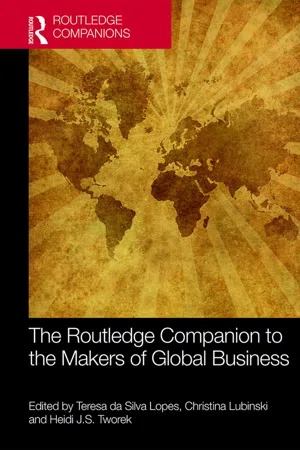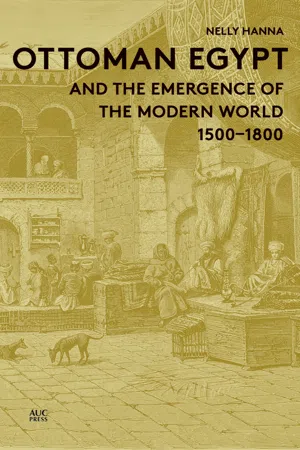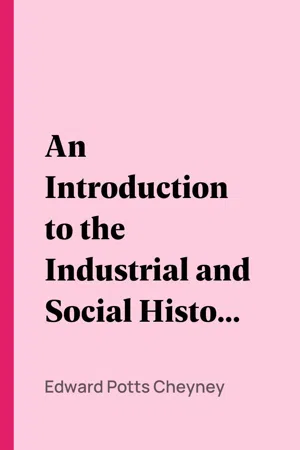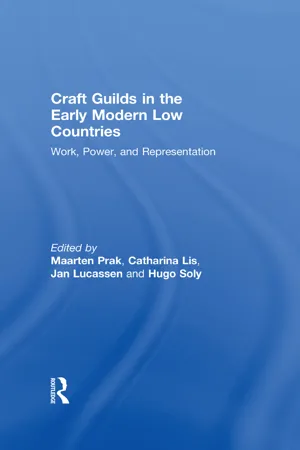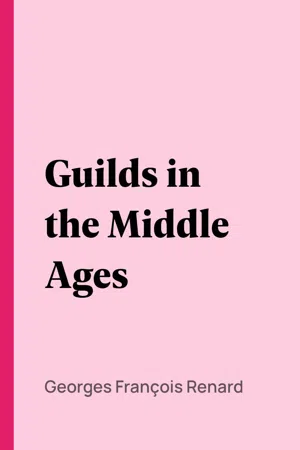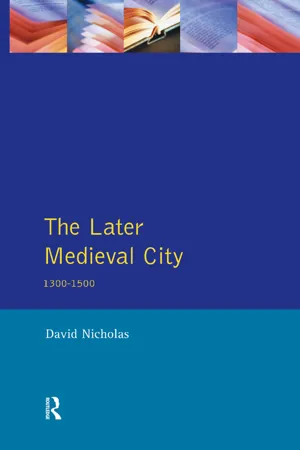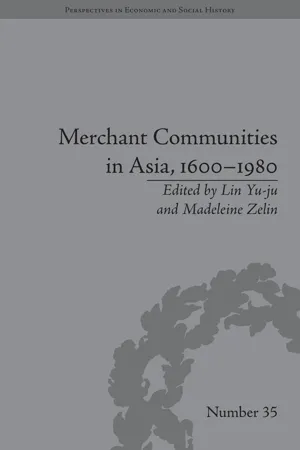History
Merchant Guilds
Merchant guilds were associations of merchants and traders formed to protect their interests and regulate trade in medieval Europe. They played a significant role in the economic and social development of towns and cities, often controlling trade monopolies and setting standards for goods and services. Guild members benefited from mutual support, access to markets, and the establishment of trade regulations.
Written by Perlego with AI-assistance
Related key terms
Related key terms
1 of 4
Related key terms
1 of 3
11 Key excerpts on "Merchant Guilds"
- eBook - ePub
- Emanuele Conte, Laurent Mayali, Emanuele Conte, Laurent Mayali(Authors)
- 2021(Publication Date)
- Bloomsbury Academic(Publisher)
This chapter examines the culture of trading in the late medieval period, a time when the occupational guilds were at the “zenith of their power” over commerce and industry in England (Gross 1890: 117). It considers the control exerted by the guilds in light of scholastic conceptions of the just price and the role of the market in establishing the value of goods for exchange, and it challenges the correctness of the prevailing modern view that the guilds operated as private interest groups, hobbling local trade for the benefit of their members by prescribing the terms on which people were able to enter into agreements with guildsmen. Specifically, it argues three things. First, it is not anachronistic to judge the guilds against the standards of modern economic thought, for while medieval trade operated in the context of a “moral universe that obliged any buyer or seller to act for the common good and agree to terms of exchange accordingly” (Langholm 1998: 85), the effect of the market, the significance of supply and demand, and the problems that could arise from the abuse of market power, had long been part of Western intellectual culture. Second, it is reasonable to conceive of the power exercised by the guilds—being in essence nothing more than a group of individuals bound together for mutual purpose (Thrupp 1942: 167; Ogilvie 2007: 1)—as private rather than public in nature, although that they were generally left to control their own affairs was a legacy of the guild merchant, which is properly viewed as a civic institution, and their authority to do so was at the pleasure of the crown and could be withdrawn. However, and lastly, although this private power could at times be exercised for the benefit of the dominant trading elite, the guilds did not enjoy a market monopoly but rather a regulatory monopoly, which operated to correct market failures and as such facilitated, rather than hindered, nascent town economies.GUILDS AND THE MEDIEVAL ECONOMYUnderstanding the impact of the guilds on commercial agreements is a particularly important endeavour. The fraternal aspect of the guilds and their broader significance in the religious and social life of medieval society is well known (for a recent appraisal, see Rosser 2015) but their role in regulating trade and industry in the towns has long been a source of contention despite—or perhaps because of—this being their primary function. The historiography has come full circle in recent years. From the late eighteenth to the early twentieth century the view was that the guilds were “archaic institutions that imposed irrational or self-serving fetters on competitive markets” (Epstein 2008: 155). Adam Smith (1776: 2.1) famously observed that:It is not from the benevolence of the butcher, the brewer, or the baker, that we expect our dinner, but from their regard to their own interest. We address ourselves, not to their humanity but to their self-love, and never talk to them of our own necessities, but of their advantages.FIGURE 4.1 Craftsmen at Work. Miniature in the book of Leonardo Dati, De Sphaera. Modena, Biblioteca Estense. 1470. Source: DEA/A. DAGLI ORTI/Getty Images. - Teresa da Silva Lopes, Christina Lubinski, Heidi J.S. Tworek, Teresa da Silva Lopes, Christina Lubinski, Heidi J.S. Tworek(Authors)
- 2019(Publication Date)
- Routledge(Publisher)
The Venetian’s account, however, shows that guild members could also contribute to the overall prosperity of England’s economy. Guild members allowed natural resources to reach international markets, and their craft skills added value to raw materials. Guild officials policed the quality of the goods distributed and manufactured by members, allowing customers to shop with confidence and contributing to the positive reputation of English products. Guild members also contributed to the economic performance of the town in which they were located. A large town or city, such as London, might have many specialist guilds producing a wide range of consumer products that attracted buyers for the domestic and global markets. An overview of crafts and companies in London in 1328–1518 demonstrates that, in the area of metal working alone, there were guilds of “armourers, bladesmiths, braziers, cardmakers [who made combs for carding wool], coppersmiths, cutlers, ferrours, founders, goldsmiths, ironmongers, latteners, lorimers, pewterers, pinners, plumbers, smiths, spurries and wiresellers” (Barron 2004: 220).Early discussion of guilds
Having considered the views of a medieval commentator, it is useful to examine the views of the earliest academics who studied the operation of guilds. Scholars have varied in their emphasis or marginalization of the functions of religious observance, social interaction, and trade promotion. They have also differed in their opinions on the benefits that guilds provided to individual members and to the overall economic performance of the town or city in which they were based (Richardson 2001).Gross is credited with establishing guilds as a field of study. Focusing on the Merchant Guilds of medieval England, Gross emphasized their contribution to the regulation of trade at the local level (1890: 37). He was especially interested in the relationship between Merchant Guilds and local government and viewed the merchant guild as essentially “a department of town administration” whose members had the right to trade freely in the town, usually in return for a small entrance fee (- eBook - ePub
- Nelly Hanna(Author)
- 2014(Publication Date)
- The American University in Cairo Press(Publisher)
These questions are easier to answer in relation to merchants than in relation to artisans. The merchants of Cairo who handled the Red Sea transit trade, spices, coffee, and Indian textiles, which were sent to numerous destinations around the Mediterranean and from there farther on, were quite likely to feel the consequences of the intensified commercial activity of the period from about 1600 to 1800. They had a quasi-monopoly over the Red Sea trade, especially when the coffee coming from Yemen that they handled ultimately reached distant parts of the world, not only in the Ottoman Empire but all over Europe, where it became one of the most fashionable drinks of the seventeenth century. It is not difficult to see that merchants would feel the consequences of an expansion in world trade.When we turn from merchants and their trade to artisans and their production, the picture is less clear and studies on the subject fewer. Views on the subject are divided. For a long time, scholars considered guilds to be structures that were static, restricted in their movements by state controls. They portrayed artisans and craftsmen as incapable of change, to a certain extent because they were governed by restrictive guild rules. For many historians, the guilds were structures ‘outside history,’ functioning regardless of their regional context. Early studies on the subject tended to emphasize the stationary character of these structures. Gabriel Baer, for example, who wrote one of the first extended studies on the subject, which remained influential for some time, considered guilds to be traditional structures bringing together persons of the same craft, headed by a shaykh. The guild was recognized by the state but was strongly influenced by state controls over its activities. The guild discouraged competition between its members but at the same time offered them fair treatment. Expansion of a guild was made difficult by restrictions for entrance, as a way of protecting its members from competition; persons who were not members of a particular guild were not allowed to undertake the activities in which it specialized.1Since then, the emergence of court records as a major source for Ottoman history has given studies on guilds a great push forward. We have numerous books and articles on many aspects of guild history in the various cities of the empire, such as Cairo, Istanbul, Bursa, Damascus, and Jerusalem. As a result, we know much more about this structure than did the scholars of a generation earlier. This new scholarship shows that guilds were flexible structures; that there was enormous variety between them; that there were various models of the relationship between guild and state as well as between guild head and guild members; and that guilds could change their internal structure over time. As more studies were undertaken, it became clear that there were also differences between the artisans and guilds of one city and those of another. In Istanbul and in other Anatolian towns, for instance, the weight of the central state on guild activity was greater than it was in Cairo since, in the view of Timur Kuran, it restricted their room for maneuver and curtailed their development.2 - Available until 19 Sep |Learn more
The Craft of Church Planting
Exploring the Lost Wisdom of Apprenticeship
- Christian Selvaratnam(Author)
- 2022(Publication Date)
- SCM Press(Publisher)
6A guild is a group of people who do the same work or who affiliate around a common interest. Though the spelling ‘guild’ is most used, it can also be written as ‘gild’ as it is derived from the Anglo-Saxon ‘Gildan’ meaning ‘to pay’. Gabriel La Bras suggests that ‘gild’ in the Germanic languages has the ancient meaning of ‘fraternities of young warriors practising the cult of heroes’ and is used in literature to refer to any group connected by rites, friendship and some shared financial resource.7 Anthony Black identifies the earliest documented use of the word in AD 450, where ‘gilda’ was a sacrificial meal associated with religious liberation and the cult of the dead. The common threads suggest that guilds are a group of people, often with subscription membership, who are connected in common purpose and relationship.There were four main kinds of medieval guild: religious guilds, for pious devotion and good works; frith guilds, for the promotion of peace, friendship and the establishment of law and order; Merchant Guilds, for trade and commerce; and craft guilds.8 Each craft guild focused on a specific artisan trade, such as candle making, weaving, bookbinding or printing. A large city in the Middle Ages might have as many as 100 different types of guild, each providing a means for trade and craft skills to be passed to the next generation.Craft guilds were associations and confraternities of artisan craft workers organized in workshop small business units which were overseen by an owner-master. The earliest English craft guilds began in London, Oxford and York.9 The first record of a trade guild in York appears in 1163 in the Acta of Henry II , which lists the granting of the King’s confirmation of the ‘weavers’ guild and customs’ in exchange for an annual payment of ten pounds. By 1180, the same record lists guilds of glovers, saddlers, hosiers and cordwainers (shoemakers) as established bodies.10 By the thirteenth century guild training in York had become prolific: for example, in 1415 there were 96 craft guilds in York,11 a time in which the population of the city was no more than 15,000 people.12 - Edward Potts Cheyney(Author)
- 2007(Publication Date)
- Perlego(Publisher)
15. The Gild Merchant. —The town was most clearly marked off from the country by the occupations by which its people earned their living. These were, in the first place, trading; secondly, manufacturing or handicrafts. Agriculture of course existed also, since most townsmen possessed some lands lying outside of the enclosed portions of the town. On these they raised crops and pastured their cattle. Of these varied occupations, however, it was trade which gave character and, indeed, existence itself to the town. Foreign goods were brought to the towns from abroad for sale, the surplus products of rural manors found their way there for marketing; the products of one part of the country which were needed in other parts were sought for and purchased in the towns. Men also sold the products of their own labor, not only food products, such as bread, meat, and fish, but also objects of manufacture, as cloth, arms, leather, and goods made of wood, leather, or metal. For the protection and regulation of this trade the organization known as the gild merchant had grown up in each town. The gild merchant seems to have included all of the population of the town who habitually engaged in the business of selling, whether commodities of their own manufacture or those they had previously purchased. Membership in the gild was not exactly coincident with burgess-ship; persons who lived outside of the town were sometimes admitted into that organization, and, on the other hand, some inhabitants of the town were not included among its members. Nevertheless, since practically all of the townsmen made their living by trade in some form or another, the group of burgesses and the group of gild members could not have been very different. The authority of the gild merchant within its field of trade regulation seems to have been as complete as that of the town community as a whole in its field of judicial, financial, and administrative jurisdiction. The gild might therefore be defined as that form of organization of the inhabitants of the town which controlled its trade and industry. The principal reason for the existence of the gild was to preserve to its own members the monopoly of trade. No one not in the gild merchant of the town could buy or sell there except under conditions imposed by the gild. Foreigners coming from other countries or traders from other English towns were prohibited from buying or selling in any way that might interfere with the interests of the gildsmen. They must buy and sell at such times and in such places and only such articles as were provided for by the gild regulations. They must in all cases pay the town tolls, from which members of the gild were exempt. At Southampton, for instance, we find the following provisions: "And no one in the city of Southampton shall buy anything to sell again in the same city unless he is of the gild merchant or of the franchise." Similarly at Leicester, in 1260, it was ordained that no gildsman should form a partnership with a stranger, allowing him to join in the profits of the sale of wool or other merchandise.Hall of Merchants' Company of York.Hall of Merchants' Company of York. (Lambert: Two Thousand Years of Gild Life. Published by A. Brown & Sons, Hull.)Interior of Hall of Merchants' Company of York.Interior of Hall of Merchants' Company of York. (Lambert: Two Thousand Years of Gild Life. Published by A. Brown & Sons, Hull.)As against outsiders the gild merchant was a protective body, as regards its own members it was looked upon and constantly spoken of as a fraternity. Its members must all share in the common expenditures, they are called brethren of the society, their competition with one another is reduced to its lowest limits. For instance, we find the provision that "any one who is of the gild merchant may share in all merchandise which another gildsman shall buy."- eBook - ePub
Craft Guilds in the Early Modern Low Countries
Work, Power, and Representation
- Catharina Lis, Hugo Soly, Maarten Prak, Maarten Prak(Authors)
- 2017(Publication Date)
- Routledge(Publisher)
But guilds did play an important role in sounding out the opinions of artisans during politically troubled times, as subsequent centuries were to prove. 14 Map 2.2 Inhabitants per guild c. 1400 Turning now to developments in the various sectors of the medieval urban economy, it is apparent that by 1400 the guilds had fully matured. While at first only merchants and woollen workers had guilds, within a few centuries a whole range of occupations had become organized particularly in industry. In the Southern Netherlands industry was somewhat more important than in the North, but transport in the Northern Netherlands was relatively more important than in the South. The distribution of guilds across the various sectors was fairly stable and after 1400 most new guilds probably resulted from existing guilds being split up. The North was somewhat more dynamic than the South — the result largely of the great expansion in services in the North from the end of the sixteenth century. Before concluding this section on developments in the Middle Ages, we would like to touch on the formal labour relations within the craft guilds. As noted earlier, the organizations discussed here generally included only masters. Occasionally, there were separate associations of journeymen and apprentices. In the case of the Southern Netherlands little research has been carried out into these associations, with the exception of the unusually active journeymen hatters. 15 The journeymen associations we know of from the fifteenth and sixteenth centuries seem initially to have been organized principally for religious purposes. However, they also served to express a collective identity, and their underlying objective might well have been to defend social and economic interests. 16 Whatever the case, it is clear that here too a critical mass was necessary before associations of journeymen could be formed - eBook - ePub
- Georges François Renard, G. D. H. (George Douglas Howard) Cole, (Authors)
- 2014(Publication Date)
- Perlego(Publisher)
The guilds of “great” commerce and of “great” industry also had their fine sense of honour, their complicated regulations, their exclusive spirit. But what distinguished them was the fact that their capital was large and that they dealt with a vast market; consequently, while the former were busy with exchange and transport, traversed land and sea with their convoys, and constituted themselves the carriers and brokers of the world, the latter intensified production; they possessed workshops which for those days were very large, and, in order to lower their general expenses, were interested in new inventions, and willingly adopted mechanical methods; at Florence, for example, metallic carders, which were still prohibited in Great Britain in 1765, were already in use under the guild system. Banking, commercial and maritime law, the science of finance, the art of production on a large scale and of securing international relations certainly owe a great deal to these merchants and manufacturers, who were the precursors of modern capitalists.The members of these powerful guilds amassed enormous fortunes, built themselves superb palaces, became counsellors and money-lenders to kings, towns, or popes. Sometimes they were too adventurous in their speculations and their bankruptcies made a wide stir. Accustomed to affairs of the highest importance and to court intrigues, they became diplomats, clever politicians, who willingly took their share in government; nor was it by chance that the first man in France who tried to reform the kingdom according to the views of the Third Estate was Étienne Marcel, provost of the richest Parisian guild. Often, however, these great burgesses were of an aristocratic spirit. In the city they opposed the rise of the lower classes, and, in their magnificent palaces, princes in fact before they were princes in name, as the Medicis became, they gradually extinguished around them the love of liberty and of republican virtues. At the same time they broke up that solidarity which was the very soul of the primitive guilds; they created a social system which perpetuated riches above and poverty below; they enslaved and cruelly exploited the clerks and workers they employed, their attitude towards whom was no longer that of masters towards journeymen or compagnons - eBook - ePub
Mutual Aid
A Factor of Evolution
- Kropotkin, Petr Alekseevich, kniaz(Authors)
- 2003(Publication Date)
- Perlego(Publisher)
The whole matter relative to the communal purchases for the use of the citizens, and the manner in which they used to be made, seems not to have yet received proper attention from the historians of the period; but there are here and there some very interesting facts which throw a new light upon it. Thus there is, among Mr. Gross's documents, a Kilkenny ordinance of the year 1367, from which we learn how the prices of the goods were established. "The merchants and the sailors," Mr. Gross writes, "were to state on oath the first cost of the goods and the expenses of transportation. Then the mayor of the town and two discreet men were to name the price at which the wares were to be sold." The same rule held good in Thurso for merchandise coming "by sea or land." This way of "naming the price" so well answers to the very conceptions of trade which were current in medieval times that it must have been all but universal. To have the price established by a third person was a very old custom; and for all interchange within the city it certainly was a widely-spread habit to leave the establishment of prices to "discreet men"—to a third party—and not to the vendor or the buyer. But this order of things takes us still further back in the history of trade—namely, to a time when trade in staple produce was carried on by the whole city, and the merchants were only the commissioners, the trustees, of the city for selling the goods which it exported. A Waterford ordinance, published also by Mr. Gross, says "that all manere of marchandis what so ever kynde thei be of … shal be bought by the Maire and balives which bene commene biers [common buyers, for the town] for the time being, and to distribute the same on freemen of the citie (the propre goods of free citisains and inhabitants only excepted)." This ordinance can hardly be explained otherwise than by admitting that all the exterior trade of the town was carried on by its agents. Moreover, we have direct evidence of such having been the case for Novgorod and Pskov. It was the Sovereign Novgorod and the Sovereign Pskov who sent their caravans of merchants to distant lands.We know also that in nearly all medieval cities of Middle and Western Europe, the craft guilds used to buy, as a body, all necessary raw produce, and to sell the produce of their work through their officials, and it is hardly possible that the same should not have been done for exterior trade—the more so as it is well known that up to the thirteenth century, not only all merchants of a given city were considered abroad as responsible in a body for debts contracted by any one of them, but the whole city as well was responsible for the debts of each one of its merchants. Only in the twelfth and thirteenth century the towns on the Rhine entered into special treaties abolishing this responsibility.(54) And finally we have the remarkable Ipswich document published by Mr. Gross, from which document we learn that the merchant guild of this town was constituted by all who had the freedom of the city, and who wished to pay their contribution ("their hanse") to the guild, the whole community discussing all together how better to maintain the merchant guild, and giving it certain privileges. The merchant guild of Ipswich thus appears rather as a body of trustees of the town than as a common private guild.In short, the more we begin to know the mediaeval city the more we see that it was not simply a political organization for the protection of certain political liberties. It was an attempt at organizing, on a much grander scale than in a village community, a close union for mutual aid and support, for consumption and production, and for social life altogether, without imposing upon men the fetters of the State, but giving full liberty of expression to the creative genius of each separate group of individuals in art, crafts, science, commerce, and political organization. How far this attempt has been successful will be best seen when we have analyzed in the next chapter the organization of labour in the medieval city and the relations of the cities with the surrounding peasant population. - eBook - ePub
The Influence and Development of English Gilds
As Illustrated by the History of the Craft Gilds of Shrewsbury
- Francis Aiden Hibbert(Author)
- 2012(Publication Date)
- Perlego(Publisher)
[61] . They became more common and more influential as the development of industry was fostered by the central government. This was especially the policy of Edward I. and Edward III. By the end of the 14th century the Craft Gilds become numerous. As they took over the duties and functions of the Merchant Gild the existence of the latter was rendered to a considerable extent superfluous, and the merging of the Gilda Mercatoria into the Communa became not only inevitable but convenient and natural. During the 14th and 15th centuries, when the Craft Gilds attained their highest power, the decay of the Merchant Gilds became very marked.The later “Merchant Gild.”In some places where this happened the name of the Merchant Gild wholly disappeared. In others where the expression continued in use the institution changed its character and became simply a religious fraternity. In a few instances the select corporation alone inherited the name: in some the whole body of freemen did so. Again, there are examples of a survival of the expression as applied to the whole body of tradesmen, that is the whole of the members of the various Gilds[62] . A Patent of Queen Elizabeth, dated 1586, thus alludes to the aggregate of unions under the collective name of “the Gild of Burgesses of Shrewsbury.” In the same way we read of “the several companies belonging to the guild merchant of Reading,” “the Guild of Merchants in Andever, which Guild is divided into three several Fellowships,” etc. Just as the Merchant Gild differentiated itself into Craft Gilds, the Craft Gilds afterwards again in the aggregate took the name and style of the Merchant Gild.Identity of interests of Corporation and Gilds seen in Police regulations;If such additional proof were needed this action on their part might be adduced in support of the assertion, which cannot be too strongly emphasised or too often repeated, that in England there was no conflict between the Merchant Gild and the Craft Gilds. Though these latter associations had grown up in vindication, as it might seem, of the principle of free amalgamation in opposition to oligarchical exclusiveness, and although it was evident that as they increased the Merchant Gild must decline, yet there was at no time any idea of antagonism between the two kinds of authority within the town. On the contrary internal police was very materially assisted by the Gilds[63] . They carried on the good work which the Merchant Gild had inaugurated. Not only were dissensions among combrethren to be brought before the Wardens and Stewards instead of forming the occasion of unseemly brawls and disturbances, but one of the objects for which the associations existed is expressly stated to be “for the weale, rest and tranquilitie of the same towne, and for good rule to be kept there[64] .” With this object in view the composition of the Tailors and Skinners (1478) contains several articles which show how materially the officers of the Gild assisted the bailiffs of the town[65] - eBook - ePub
The Later Medieval City
1300-1500
- David Nicholas(Author)
- 2014(Publication Date)
- Routledge(Publisher)
The number of bayles tended to increase as the trade became less accessible to newcomers and powers of the general assembly of the trade declined. The consuls gradually placed the treasuries of the craft confraternities under the bayles. The bayle also controlled the corporate seal of the city that was required for all sales. In some trades he could judge civil and even criminal actions between members. 114 Restrictions on mastership An important element of the prestige of guilds was the extent to which they could restrict access to mastership and thus make themselves more exclusive and lineage-based. While occupational organisations of the central Middle Ages had generally been open to qualified outsiders, the late medieval guilds were closing. Given the ubiquity of family-based enterprises, the guilds amounted to associations of families that practised the same or similar trades. The tendency to hereditary succession of mastership existed in most guilds, but it was rarely unbreachable except for a few politically prominent guilds, most conspicuously the butchers. This did not mean that only masters could work, for trained journeymen provided much of the labour force. 115 Rules for mastership thus ossified. Some guilds developed criteria of wealth. The richer guilds of Cologne required masters to have a coat of mail, an iron helmet and a crossbow. 116 Masterworks, which few guilds had required earlier, became more common as tests of professional competence in Languedoc in the fifteenth century. As late as 1500 only five guilds of Lille required a masterwork, including the smiths and barbers. In other cases the master simply certified his apprentice, whose work had doubtless been observed by most masters in the guild, or enfranchised his sons. The masterwork was rare in the Upper Rhine cities before the late fourteenth century, but the saddlers and shoemakers of the region used it by 1464. It became general in Paris in the fifteenth century - eBook - ePub
- Madeleine Zelin(Author)
- 2015(Publication Date)
- Routledge(Publisher)
45 We can surmise that approximately 10,000 people were engaged in the merchant guild in Seoul in late Chosŏn Korea. If we include their family members, the number of people in merchant households is roughly 40,000. Considering that the population in the capital city Seoul in the eighteenth century was about 200,000, almost 20 per cent of citizens were related with the activities of Merchant Guilds.Institution of Shijŏn Guilds
The shijŏn guild had several functions.46 These functions include the following: (a) management of relations with the government, particularly in terms of tax and other duties; (b) protection of the privileges of the guild merchants against outside competition; (c) promotion of mutual benefit and friendly relations among merchants, and mediation in any dispute; and (d) in shijŏn that combined production and trade, tojung officers oversaw the purchase of raw materials and the manufacture and sale of finished products. To understand the multiple facets of Merchant Guilds, we divide the functions into two aspects, namely, privileges and obligations.With the political authorities, the shijŏn guild had both privileges (or benefits) and obligations (or responsibilities). Privileges came in three forms. First, shijŏn merchants had shops to sell commodities every day, whereas other merchants did not have the opportunity to formally open shops in Seoul. The second and major privilege was the monopoly right over the commodities that were dealt in by each chŏn . As will be discussed in the next section, the government protected the business district of each merchant guild. The third privilege was the provision of government emergency relief to each merchant guild in case of fire.47Among the obligations, the first and most important one was the regular procurement of commodities for the courts and government offices, called chinbae . In a certain sense, this obligation could be considered a privilege when the government budget was favourable; however, it could be a burden when government revenue was in deficit. The procurement process involved several steps. First, the government office in need of certain commodities sent the request list to the relevant shijŏn guild. After confirming the list, the corresponding tojung allocated the procurement amount to its member merchants who conducted their business in each pang . A recent study highlighted the systematic process and well-organized document structure in the procurement process in royal finance.48
Index pages curate the most relevant extracts from our library of academic textbooks. They’ve been created using an in-house natural language model (NLM), each adding context and meaning to key research topics.
Explore more topic indexes
Explore more topic indexes
1 of 6
Explore more topic indexes
1 of 4

